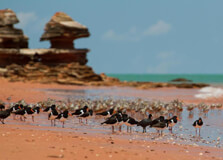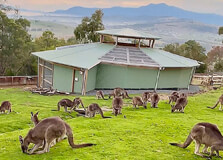
- Home
- Travel Packages
- Top Destination
-
Travel Attraction
By Category
Top Attraction

- Travel Agents
- Car Rentals
- Hotels

The Broome Bird Observatory is a unique and peaceful destination located on the shores of Roebuck Bay, just outside the town of Broome, Western Australia. It was established in 1988 to promote the understanding and conservation of migratory shorebirds and other bird species that visit or live in the region. The observatory is considered one of the best places in Australia—and even the world—to observe shorebirds in their natural habitat. With over 300 bird species recorded in the area, it’s a paradise for bird watchers, researchers, and nature lovers. Visitors can enjoy guided tours, educational activities, and relaxing stays while surrounded by the tranquil beauty of the Australian bush and tidal wetlands. How to Reach Broome Bird Observatory, Broome The Broome Bird Observatory is located about 25 kilometers southeast of Broome town center, on Crab Creek Road. To reach the observatory, you will need a 4WD vehicle as the road is unsealed and can be rough, especially during the wet season. Follow signs along Crab Creek Road from Broome. If you don’t have a suitable vehicle, the observatory offers transfer services, or you can book guided tours that include transport. Always check road conditions before your journey, particularly during or after rainfall. Weather The climate at Broome Bird Observatory is tropical, with two distinct seasons: the dry season (April to October) and the wet season (November to March). The dry season offers the best birdwatching conditions, with clear skies, lower humidity, and pleasant temperatures ranging from 17°C to 30°C. The wet season brings hotter temperatures, high humidity, and occasional storms. While bird activity continues during this time, access to the observatory may be limited due to road conditions. Timing The Broome Bird Observatory is open year-round. Reception hours for check-ins are typically from 8:00 AM to 5:00 PM, but it's recommended to contact them in advance if arriving outside these times. Birdwatching is best done during early morning and late afternoon when birds are most active and the temperatures are cooler. Specific tours and activities may have scheduled times, so it’s best to book in advance. Why Famous for Broome? Broome is world-famous for its role as a key stopover site for migratory birds that travel between the Arctic and Australia. Roebuck Bay, where the observatory is located, is an internationally recognized wetland under the Ramsar Convention. The mudflats and mangroves of the bay support thousands of birds during their long journeys. This has made Broome a hotspot for ornithologists, birdwatchers, and conservationists. The Broome Bird Observatory plays a central role in this reputation, contributing to research, education, and environmental awareness. Entry and Visit Details about Broome Bird Observatory, Broome Entry to the observatory grounds is free for day visitors. However, guided tours, accommodation, and educational programs have associated fees. The observatory offers several options for staying overnight, including eco-tents, bunkhouse rooms, and camping areas. Facilities include shared bathrooms, a communal kitchen, picnic spots, and a gift shop. Pets are not allowed, and visitors are encouraged to respect the natural environment and the wildlife. Booking in advance is recommended for tours and accommodation, especially during peak bird migration seasons in March-April and September-October. History and Architecture The Broome Bird Observatory was established in 1988 by Birds Australia (now BirdLife Australia) with the goal of promoting bird conservation and ecological understanding. It was built with simplicity in mind, to minimize impact on the environment and provide a space for both research and relaxation. The buildings are designed to blend with the natural landscape and offer functional, eco-friendly shelter. You'll find shaded verandas, open-air classrooms, and viewing areas built to optimize the birdwatching experience without disturbing wildlife. The observatory also features educational displays and maps that highlight migratory bird routes, local ecosystems, and conservation efforts. Things to Do The Broome Bird Observatory offers a wide range of engaging activities for visitors: Birdwatching Tours: Join guided tours such as "Shorebirds Tour", "Mangrove Tour", and "Yellow Chat Twitch" to observe rare and migratory species. Self-Guided Walks: Explore the walking trails around the observatory, with signs and lookout points for easy bird spotting. Photography: The landscape and bird activity make it an ideal place for nature photography. Educational Programs: Participate in workshops, talks, and school visits focused on bird conservation and habitat awareness. Camping and Stargazing: Stay overnight and enjoy the peaceful sounds of nature and clear night skies. Research Support: The observatory supports scientists and students conducting research on migratory patterns, habitat health, and more. Facts and Tips about Broome Bird Observatory, Broome Here are some useful facts and tips to enhance your visit: Over 300 Species: More than 300 species of birds have been recorded here, including the rare Yellow Chat and Great Knot. Best Time to Visit: March to May and August to October are peak times for bird migration and the best periods for birdwatching. Bring Binoculars: Essential for spotting birds from viewing shelters and along trails. Wear Appropriate Clothing: Lightweight, long-sleeved shirts, a hat, and closed shoes are ideal for sun and insect protection. Book Early: Accommodation and tours can fill quickly during peak season, so plan ahead. Respect the Habitat: Avoid making loud noises or sudden movements that could disturb the birds. The Broome Bird Observatory is more than just a place to see birds—it's a gateway to understanding nature on a deeper level. With its peaceful surroundings, abundant wildlife, and strong conservation mission, the observatory offers an enriching experience for anyone who loves the outdoors and cares about the environment. Whether you’re an expert birder or a curious traveler, your visit to this special place will be both relaxing and enlightening.
Explore More
Bonorong Wildlife Sanctuary is one of Tasmania’s most popular wildlife parks and is located just 30 minutes from Hobart. It’s not just a sanctuary – it’s a place where injured and orphaned native animals are rescued, rehabilitated, and released when possible. Bonorong is run with a strong focus on animal welfare and conservation, and it offers a unique opportunity to get close to Australia’s most famous and rare wildlife, including Tasmanian devils, kangaroos, wombats, koalas, and many more. The sanctuary is ideal for families, animal lovers, and those wanting to learn more about Tasmania's unique native species. Visitors can enjoy a hands-on experience, learn from passionate wildlife keepers, and even feed free-roaming kangaroos. The sanctuary also works as a hospital for injured wildlife, supported by community donations and entry fees. How to Reach Bonorong Wildlife Sanctuary, Hobart Bonorong Wildlife Sanctuary is located in Brighton, about 26 kilometers north of Hobart. The easiest and fastest way to get there is by car, which takes around 30–35 minutes from Hobart’s city center. The drive is simple and scenic, following the Midland Highway (A1) and then turning onto Brighton Road. If you don’t have access to a car, there are also several tour companies that include Bonorong as part of their itinerary. Some public transport options are available, but they may not be direct, and you may need to combine a train or bus with a taxi to reach the sanctuary. Weather Bonorong Wildlife Sanctuary experiences the same temperate climate as the Hobart region. Summers (December to February) are mild and pleasant, with daytime temperatures between 17°C to 24°C. Winter months (June to August) are cooler, averaging between 5°C to 12°C. Spring and autumn are beautiful seasons to visit with fewer crowds and mild weather. Since much of the sanctuary is outdoors, it’s best to dress in layers and bring sun protection during summer and a rain jacket or warm clothes during the cooler seasons. Timing Bonorong Wildlife Sanctuary is open every day of the year, including public holidays. The standard opening hours are from 9:00 AM to 5:00 PM. The last admission is typically around 4:00 PM, so it's a good idea to arrive earlier to make the most of your visit. Special night tours and private experiences are available outside regular hours but require prior booking. These tours allow visitors to see nocturnal animals and learn more about the sanctuary’s rescue efforts. Why Bonorong is Famous in Hobart Bonorong Wildlife Sanctuary is famous for being one of the leading wildlife rescue and rehabilitation centers in Tasmania. It is well-known for its work with the endangered Tasmanian devil and its large population of free-roaming kangaroos that visitors can hand-feed. The sanctuary is also famous for offering up-close and personal wildlife experiences that are ethical and educational. Visitors can meet wombats, echidnas, tawny frogmouths, and many more animals, all under the guidance of expert wildlife keepers. Its strong focus on conservation, wildlife rescue, and community education has made it a standout attraction in the Hobart area. Entry and Visit Details Entry to Bonorong Wildlife Sanctuary is ticketed, with all proceeds supporting the sanctuary's operations and animal care programs. General admission costs approximately: Adults: AUD $36 Children (3–15 years): AUD $20 Family Pass: AUD $92 (2 adults + 2 children) Tickets can be purchased at the gate or online through their official website. Guided tours are included in the entry fee and run several times a day. Visitors are free to explore the sanctuary at their own pace as well. There is also a gift shop and café on-site for snacks and souvenirs. Parking is free and available directly outside the sanctuary. History and Architecture Bonorong Wildlife Sanctuary was established in 1981 and started as a small park to showcase Tasmania’s native animals. Over time, it grew into a full-scale sanctuary with a mission to rescue, rehabilitate, and release wildlife across the state. The sanctuary doesn’t feature grand historical buildings or colonial architecture, but its structures are functional and eco-friendly, blending naturally with the surroundings. Its most valuable feature is its purpose-built animal hospital and the natural enclosures designed to mimic the animals’ native environments. Things to Do at Bonorong Wildlife Sanctuary Hand-feed Kangaroos: Visitors receive a bag of food and can interact with the friendly kangaroos in the large open area. See Tasmanian Devils: Learn about this iconic and endangered species and watch them feed and play. Join Keeper Talks: Daily talks offer fascinating insights into the lives of wombats, koalas, devils, and more. Wildlife Hospital Visit: Gain behind-the-scenes knowledge of how animals are treated and rehabilitated. Participate in Night Tours: See nocturnal animals in action and enjoy a more private experience with fewer visitors. Photography: Bring your camera – there are many photo opportunities with animals and beautiful natural backdrops. Facts and Tips about Bonorong Wildlife Sanctuary, Hobart Bonorong means “native companion” in an Aboriginal language. The sanctuary operates Tasmania’s largest 24/7 wildlife rescue service. No dogs or pets are allowed inside the sanctuary due to the presence of wildlife. Feeding kangaroos is safe and a highlight for children and adults alike. Support the cause by adopting an animal through their symbolic adoption program. Guided tours are included in the entry fee – don’t miss them for a more informative experience. Wear comfortable walking shoes – the paths are easy to walk but involve some outdoor terrain. Most of the sanctuary is accessible to wheelchairs and strollers. Bonorong Wildlife Sanctuary offers a heartwarming, educational, and unforgettable experience just outside of Hobart. It’s not only a place to see animals up close but also to learn about conservation efforts and the importance of protecting Australia's unique wildlife. A visit here supports a great cause and leaves visitors with lasting memories of connecting with nature and animals in a respectful and caring environment.
Explore More